Lexmark MS711DN Manual

MS710 Series
User's Guide
June 2017 |
www.lexmark.com |
|
|
Machine type(s):
4063
Model(s):
832, 835

Contents |
2 |
Contents |
|
Safety information........................................................................................ |
5 |
Conventions.......................................................................................................................................................... |
5 |
Learning about the printer........................................................................... |
7 |
Finding information about the printer............................................................................................................. |
7 |
Selecting a location for the printer.................................................................................................................. |
8 |
Printer configurations......................................................................................................................................... |
9 |
Using the printer control panel........................................................................................................................ |
11 |
Understanding the colors of the Sleep button and indicator lights...................................................... |
12 |
Additional printer setup.............................................................................. |
13 |
Installing internal options................................................................................................................................. |
13 |
Installing hardware options............................................................................................................................ |
30 |
Attaching cables................................................................................................................................................ |
34 |
Setting up the printer software...................................................................................................................... |
36 |
Networking.......................................................................................................................................................... |
37 |
Verifying printer setup....................................................................................................................................... |
41 |
Loading paper and specialty media......................................................... |
42 |
Setting the paper size and type.................................................................................................................... |
42 |
Configuring Universal paper settings.......................................................................................................... |
42 |
Loading the 250 or 550 sheet tray............................................................................................................. |
42 |
Loading the 2100 sheet tray.......................................................................................................................... |
49 |
Loading the multipurpose feeder................................................................................................................. |
55 |
Linking and unlinking trays............................................................................................................................. |
60 |
Paper and specialty media guide............................................................. |
62 |
Using specialty media...................................................................................................................................... |
62 |
Paper guidelines................................................................................................................................................ |
63 |
Supported paper sizes, types, and weights............................................................................................... |
66 |
Printing.......................................................................................................... |
71 |
Printing a document........................................................................................................................................... |
71 |
Printing from a flash drive................................................................................................................................ |
72 |
Printing from a mobile device......................................................................................................................... |
74 |

Contents |
3 |
Printing confidential and other held jobs.................................................................................................... |
74 |
Printing information pages.............................................................................................................................. |
76 |
Canceling a print job......................................................................................................................................... |
76 |
Understanding the printer menus............................................................ |
77 |
Menus list............................................................................................................................................................. |
77 |
Paper menu......................................................................................................................................................... |
78 |
Reports menu..................................................................................................................................................... |
88 |
Network/Ports menu......................................................................................................................................... |
89 |
Security menu................................................................................................................................................... |
102 |
Settings menu................................................................................................................................................... |
105 |
Help menu......................................................................................................................................................... |
123 |
Saving money and the environment...................................................... |
125 |
Saving paper and toner.................................................................................................................................. |
125 |
Saving energy................................................................................................................................................... |
125 |
Recycling............................................................................................................................................................ |
128 |
Securing the printer.................................................................................. |
130 |
Using the security lock feature.................................................................................................................... |
130 |
Statement of Volatility..................................................................................................................................... |
130 |
Erasing volatile memory.................................................................................................................................. |
131 |
Erasing non volatile memory......................................................................................................................... |
131 |
Erasing printer hard disk memory............................................................................................................... |
132 |
Configuring printer hard disk encryption................................................................................................... |
132 |
Finding printer security information............................................................................................................ |
133 |
Maintaining the printer............................................................................. |
134 |
Cleaning the printer......................................................................................................................................... |
134 |
Checking the status of parts and supplies................................................................................................ |
135 |
Ordering supplies............................................................................................................................................. |
137 |
Storing supplies................................................................................................................................................ |
139 |
Replacing supplies.......................................................................................................................................... |
140 |
Moving the printer........................................................................................................................................... |
149 |
Managing the printer................................................................................ |
152 |
Finding advanced networking and administrator information............................................................. |
152 |
Accessing the remote control panel........................................................................................................... |
152 |

Contents |
4 |
Modifying confidential print settings.......................................................................................................... |
152 |
Copying printer settings to other printers................................................................................................. |
153 |
Restoring factory default settings................................................................................................................ |
153 |
Clearing jams............................................................................................. |
154 |
Avoiding jams.................................................................................................................................................... |
154 |
Identifying jam locations................................................................................................................................ |
156 |
Paper jam in the front door........................................................................................................................... |
158 |
Paper jam in the rear door............................................................................................................................. |
159 |
Paper jam in the standard bin....................................................................................................................... |
162 |
Paper jam in the duplex unit......................................................................................................................... |
162 |
Paper jam in trays............................................................................................................................................ |
163 |
Paper jam in the multipurpose feeder........................................................................................................ |
164 |
Paper jam in the staple finisher.................................................................................................................... |
165 |
Staple jam in the finisher................................................................................................................................ |
167 |
Paper jam in the output expander............................................................................................................... |
170 |
Paper jam in the mailbox................................................................................................................................. |
171 |
Troubleshooting........................................................................................ |
173 |
Understanding the printer messages......................................................................................................... |
173 |
Solving printer problems................................................................................................................................. |
191 |
Solving print problems.................................................................................................................................. |
200 |
Embedded Web Server does not open.................................................................................................... |
227 |
Contacting customer support...................................................................................................................... |
228 |
Notices....................................................................................................... |
229 |
Product information........................................................................................................................................ |
229 |
Edition notice................................................................................................................................................... |
229 |
Power consumption........................................................................................................................................ |
234 |
Index.......................................................................................................... |
240 |

Safety information |
5 |
Safety information
Conventions
Note: A note identifies information that could help you.
Warning: A warning identifies something that could damage the product hardware or software.
CAUTION: A caution indicates a potentially hazardous situation that could injure you.
Different types of caution statements include:
 CAUTION—POTENTIAL INJURY: Indicates a risk of injury.
CAUTION—POTENTIAL INJURY: Indicates a risk of injury.
 CAUTION—SHOCK HAZARD: Indicates a risk of electrical shock.
CAUTION—SHOCK HAZARD: Indicates a risk of electrical shock.
 CAUTION—HOT SURFACE: Indicates a risk of burn if touched.
CAUTION—HOT SURFACE: Indicates a risk of burn if touched.
 CAUTION—TIPPING HAZARD: Indicates a crush hazard.
CAUTION—TIPPING HAZARD: Indicates a crush hazard.
 CAUTION—PINCH HAZARD: Indicates a risk of being caught between moving parts.
CAUTION—PINCH HAZARD: Indicates a risk of being caught between moving parts.
CAUTION—POTENTIAL INJURY: To avoid the risk of fire or electrical shock, connect the power cord to an appropriately rated and properly grounded electrical outlet that is near the product and easily accessible.
CAUTION—POTENTIAL INJURY: Do not use this product with extension cords, multioutlet power strips, multioutlet extenders, or UPS devices. The power capacity of these types of accessories can be easily overloaded by a laser printer and may result in a risk of fire, property damage, or poor printer performance.
CAUTION—SHOCK HAZARD: To avoid the risk of electrical shock, do not place or use this product near water or wet locations.
CAUTION—POTENTIAL INJURY: This product uses a laser. Use of controls or adjustments or performance of procedures other than those specified in the User’s Guide may result in hazardous radiation exposure.
This product uses a printing process that heats the print media, and the heat may cause the media to release emissions. You must understand the section in your operating instructions that discusses the guidelines for selecting print media to avoid the possibility of harmful emissions.
CAUTION—POTENTIAL INJURY: The lithium battery in this product is not intended to be replaced. There is a danger of explosion if a lithium battery is incorrectly replaced. Do not recharge, disassemble, or incinerate a lithium battery. Discard used lithium batteries according to the manufacturer's instructions and local regulations.
This equipment is not suitable for use in locations where children are likely to be present.
CAUTION—HOT SURFACE: The inside of the printer might be hot. To reduce the risk of injury from a hot component, allow the surface to cool before touching it.
CAUTION—POTENTIAL INJURY: To reduce the risk of equipment instability, load each tray separately. Keep all other trays closed until needed.

Safety information |
6 |
CAUTION—POTENTIAL INJURY: The printer weight is greater than 18 kg (40 lb) and requires two or more trained personnel to lift it safely.
CAUTION—POTENTIAL INJURY: Before moving the printer, follow these guidelines to avoid personal injury or printer damage:
•Turn off the printer, and then unplug the power cord from the electrical outlet.
•Disconnect all cords and cables from the printer.
•If two or more optional finishers are installed, then remove the finishers individually from the printer.
Notes:
–Make sure to remove the topmost finisher first.
–To remove the finisher, hold the finisher on both sides, and then lift the latches to unlock the finisher.
•If the printer does not have a caster base but is configured with optional trays, then remove the trays.
Note: Slide the latch on the right side of the optional tray toward the front of the tray until it clicks into place.
•Use the handholds located on both sides of the printer to lift it.
•Make sure your fingers are not under the printer when you set it down.
•Make sure there is adequate clearance around the printer.
•Use only the power cord provided with this product or the manufacturer's authorized replacement.
CAUTION—SHOCK HAZARD: If you are accessing the controller board or installing optional hardware or memory devices sometime after setting up the printer, then turn the printer off, and unplug the power cord from the electrical outlet before continuing. If you have any other devices attached to the printer, then turn them off as well, and unplug any cables going into the printer.
CAUTION—SHOCK HAZARD: To avoid the risk of electrical shock when cleaning the exterior of the printer, unplug the power cord from the electrical outlet and disconnect all cables from the printer before proceeding.
CAUTION—SHOCK HAZARD: To avoid the risk of electrical shock, make sure that all external connections (such as Ethernet and telephone system connections) are properly installed in their marked plug-in ports.
This product is designed, tested, and approved to meet strict global safety standards with the use of specific manufacturer's components. The safety features of some parts may not always be obvious. The manufacturer is not responsible for the use of other replacement parts.
CAUTION—POTENTIAL INJURY: Do not cut, twist, bind, crush, or place heavy objects on the power cord. Do not subject the power cord to abrasion or stress. Do not pinch the power cord between objects such as furniture and walls. If any of these things happen, a risk of fire or electrical shock results. Inspect the power cord regularly for signs of such problems. Remove the power cord from the electrical outlet before inspecting it.
Refer service or repairs, other than those described in the user documentation, to a service representative.
CAUTION—SHOCK HAZARD: Do not set up this product or make any electrical or cabling connections, such as a power cord, a fax feature or USB cable, during a lightning storm.
 CAUTION—TIPPING HAZARD: Floor-mounted configurations require additional furniture for stability.
CAUTION—TIPPING HAZARD: Floor-mounted configurations require additional furniture for stability.  You must use either a printer stand or printer base if you are using multiple input options. If you purchased a printer with a similar configuration, then you may need additional furniture. For more information, see www.lexmark.com/multifunctionprinters.
You must use either a printer stand or printer base if you are using multiple input options. If you purchased a printer with a similar configuration, then you may need additional furniture. For more information, see www.lexmark.com/multifunctionprinters.
SAVE THESE INSTRUCTIONS.

Learning about the printer |
7 |
Learning about the printer 
Finding information about the printer
|
What are you looking for? |
Find it here |
||
|
Initial setup instructions: |
Setup documentation—The setup documentation |
||
|
• |
Connecting the printer |
came with the printer and is also available at |
|
|
• |
Installing the printer software |
http://support.lexmark.com. |
|
|
|
|
||
|
|
|
||
|
Additional setup and instructions for using the printer: |
User's Guide and Quick Reference Guide—The |
||
|
• |
Selecting and storing paper and specialty media |
guides are available at http://support.lexmark.com. |
|
|
• |
Loading paper |
Note: These guides are also available in other |
|
|
• |
Configuring printer settings |
languages. |
|
|
|
|
||
|
• |
Viewing and printing documents and photos |
|
|
|
• |
Setting up and using the printer software |
|
|
|
• |
Configuring the printer on a network |
|
|
|
• |
Caring for and maintaining the printer |
|
|
|
• |
Troubleshooting and solving problems |
|
|
|
|
|
||
|
Information on setting up and configuring the accessibility |
Lexmark Accessibility Guide—This guide is available |
||
|
features of your printer |
at http://support.lexmark.com. |
||
|
|
|
||
|
Help using the printer software |
Windows or Mac Help—Open a printer software |
||
|
|
|
program or application, and then click Help. |
|
|
|
|
Click ? to view context sensitive information. |
|
|
|
|
Notes: |
|
|
|
|
• |
Help is automatically installed with the printer |
|
|
|
|
software. |
|
|
|
• |
The printer software is located in the printer |
|
|
|
|
program folder or on the desktop, depending |
|
|
|
|
on your operating system. |
|
|
|
|
|
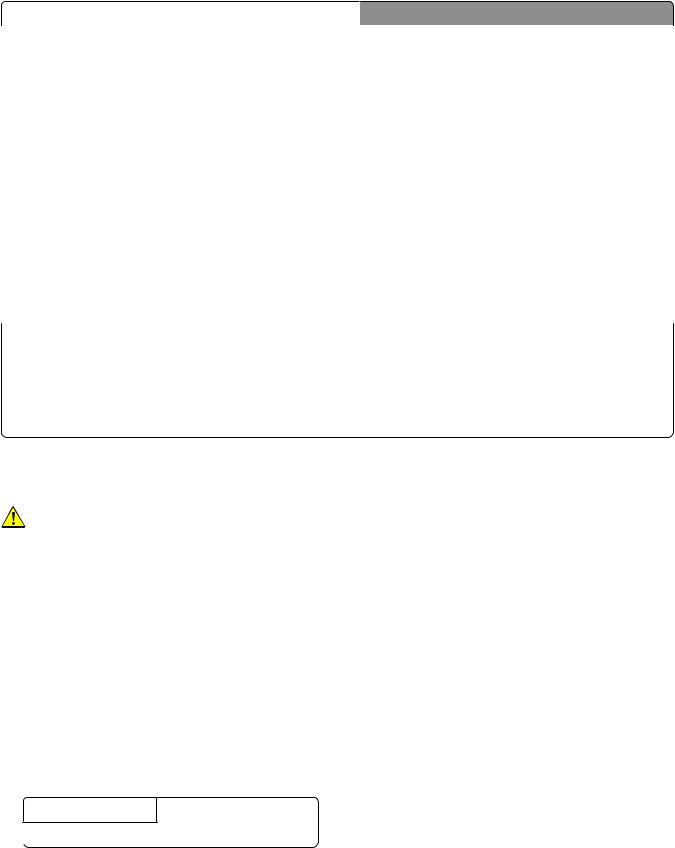
Learning about the printer |
|
8 |
||
|
|
|
|
|
|
What are you looking for? |
Find it here |
||
|
The latest supplemental information, updates, and customer |
Lexmark support Web site— |
||
|
support: |
http://support.lexmark.com |
||
|
• |
Documentation |
Note: Select your country or region, and then select |
|
|
• |
Driver downloads |
your product to view the appropriate support site. |
|
|
• |
Live chat support |
Support telephone numbers and hours of operation |
|
|
• |
E mail support |
for your country or region can be found on the |
|
|
support Web site or on the printed warranty that came |
|||
|
• |
Voice support |
||
|
with your printer. |
|||
|
|
|
||
|
|
|
Record the following information (located on the |
|
|
|
|
store receipt and at the back of the printer), and have |
|
|
|
|
it ready when you contact customer support so that |
|
|
|
|
they may serve you faster: |
|
|
|
|
• |
Machine Type number |
|
|
|
• |
Serial number |
|
|
|
• |
Date purchased |
|
|
|
• |
Store where purchased |
|
|
|
||
|
Warranty information |
Warranty information varies by country or region: |
||
|
|
|
• |
In the U.S.—See the Statement of Limited |
|
|
|
|
Warranty included with this printer, or go to |
|
|
|
|
http://support.lexmark.com. |
|
|
|
• |
In other countries and regions—See the printed |
|
|
|
|
warranty that came with this printer. |
|
|
|
|
|
Selecting a location for the printer
CAUTION—POTENTIAL INJURY: The printer weight is greater than 18 kg (40 lb) and requires two or more trained personnel to lift it safely.
When selecting a location for the printer, leave enough room to open trays, covers, and doors. If you plan to install any options, then leave enough room for them also. It is important to:
•Set up the printer near a properly grounded and easily accessible electrical outlet.
•Make sure airflow in the room meets the latest revision of the ASHRAE 62 standard or the CEN Technical Committee 156 standard.
•Provide a flat, sturdy, and stable surface.
•Keep the printer:
–Clean, dry, and free of dust.
–Away from stray staples and paper clips.
–Away from the direct airflow of air conditioners, heaters, or ventilators.
–Free from direct sunlight and humidity extremes.
•Observe the recommended temperatures and avoid fluctuations:
Ambient temperature 15.6 to 32.2°C (60 to 90°F)
 Storage temperature -40 to 43°C (-40 to 110°F)
Storage temperature -40 to 43°C (-40 to 110°F)
• Allow the following recommended amount of space around the printer for proper ventilation:
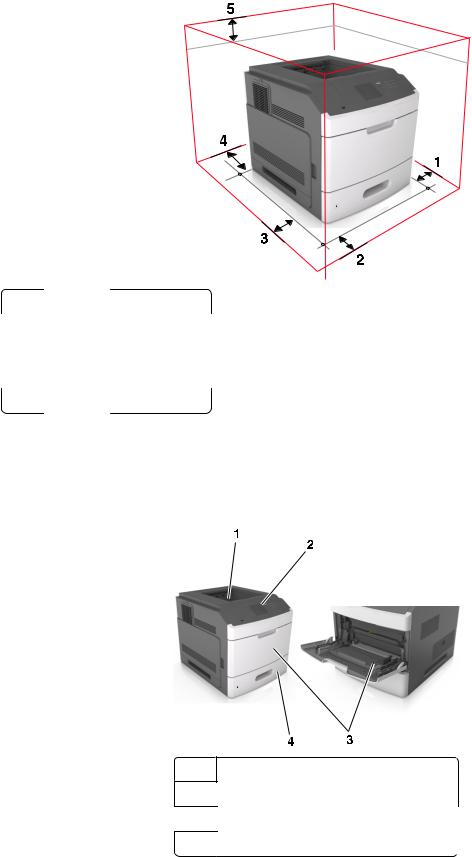
Learning about the printer |
9 |
1 |
Right side |
305 mm (12 in.) |
|
|
|
2 |
Front |
508 mm (20 in.) |
|
|
|
3 |
Left side |
305 mm (12 in.) |
|
|
|
4 |
Rear |
305 mm (12 in.) |
|
|
|
5 |
Top |
115 mm (4.5 in.) |
|
|
|
Printer configurations
Basic model
1 Standard bin
2Printer control panel
3Multipurpose feeder
4 Standard 250 or 550 sheet tray (Tray 1)

Learning about the printer |
10 |
Fully configured model

 CAUTION—TIPPING HAZARD: Floor-mounted configurations require additional furniture for stability.
CAUTION—TIPPING HAZARD: Floor-mounted configurations require additional furniture for stability.  You must use either a printer stand or printer base if you are using multiple input options. If you purchased a printer with a similar configuration, then you may need additional furniture. For more information, see www.lexmark.com/multifunctionprinters.
You must use either a printer stand or printer base if you are using multiple input options. If you purchased a printer with a similar configuration, then you may need additional furniture. For more information, see www.lexmark.com/multifunctionprinters.
The following illustration shows the maximum number of optional finishers and trays that are supported by the printer. For more information on other configurations, visit www.lexmark.com/multifunctionprinters.
|
|
Hardware option |
Alternative hardware option |
|
|
1 |
Staple finisher |
• |
Output expander |
|
|
|
• |
4 bin mailbox |
|
|
|
• |
Staple, hole punch finisher |
|
|
|
|
|
|
2 |
4 bin mailbox |
• |
Output expander |
|
|
|
• |
High capacity output expander |
|
|
|
• |
Staple, hole punch finisher |
|
|
|
|
|
|
3 |
Caster base |
None |
|
|
|
|
|
|
|
4 |
2100 sheet tray |
None |
|
|
5 |
550 sheet tray |
250 sheet tray |
|
|
6 |
250 sheet tray |
550 sheet tray |
|
|
7 |
4 bin mailbox |
Output expander |
|
|
8 |
Output expander |
4 bin mailbox |
|

Learning about the printer |
11 |
The staple, hole punch finisher must not be combined with any other output option. In a configuration with two or more optional finishers:
•The staple finisher must always be on top.
•The high capacity output expander must always be at the bottom.
•The output expander is the only option that can be placed on top of the high capacity output expander.
•The output expander and mailbox may be installed in any order.
When using optional trays:
•Always use a caster base when the printer is configured with a 2100 sheet tray.
•The 2100 sheet tray must always be at the bottom of a configuration.
•A maximum of four optional trays may be configured with the printer.
•The optional 250 and 550 sheet trays may be installed in any order.
Using the printer control panel
1 |
2 |
3 |
4 |
5 |
|
|
|
|
|
10 |
|
|
8 |
6 |
|
|
9 |
7 |
||
|
|
|
|
|
|
|
Use the |
To |
|
|
|
1 |
Display |
• |
View the printer status. |
||
|
|
• |
Set up and operate the printer. |
||
|
|
|
|||
2 |
Select button |
Submit changes made in the printer settings. |
|||
|
|
|
|||
3 |
Arrow buttons |
Scroll up and down or left and right. |
|||
|
|
|
|||
4 |
Keypad |
Enter numbers, letters, or symbols. |
|||
|
|
|
|||
5 |
Sleep button |
Enable Sleep mode or Hibernate mode. |
|||
|
|
Do the following to wake the printer from Sleep mode: |
|||
|
|
• |
Press any hard button. |
||
|
|
• |
Pull out Tray 1 or load paper in the multipurpose feeder. |
||
|
|
• |
Open a door or cover. |
||
|
|
• |
Send a print job from the computer. |
||
|
|
• |
Perform a power on reset with the main power switch. |
||
|
|
• |
Attach a device to the USB port on the printer. |
||
6Stop or Cancel button Stop all printer activity.
7 Back button |
Return to the previous screen. |
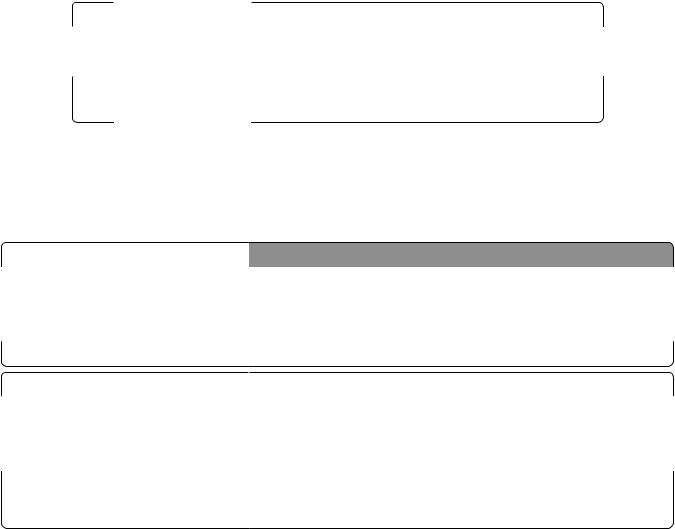
Learning about the printer |
12 |
|||
|
|
|
|
|
|
|
Use the |
To |
|
|
8 |
Home button |
Go to the home screen. |
|
|
|
|
|
|
|
9 |
Indicator light |
Check the status of the printer. |
|
|
|
|
|
|
10 |
USB port |
Connect a flash drive to the printer. |
||
|
|
|
Note: Only the front USB port supports flash drives. |
|
|
|
|
|
|
Understanding the colors of the Sleep button and indicator lights
The colors of the Sleep button and indicator lights on the control panel signify a printer status or condition.
|
Indicator light |
Printer status |
|
Off |
The printer is off or in Hibernate mode. |
|
|
|
|
Blinking green |
The printer is warming up, processing data, or printing. |
|
|
|
|
Solid green |
The printer is on, but idle. |
|
|
|
|
Blinking red |
The printer requires user intervention. |
|
|
|
|
Sleep button light |
Printer status |
|
Off |
The printer is off, idle, or in Ready state. |
|
|
|
|
Solid amber |
The printer is in Sleep mode. |
|
|
|
|
Blinking amber |
The printer is entering or waking from Hibernate mode. |
|
|
|
|
Blinking amber for 0.1 second, then goes |
The printer is in Hibernate mode. |
|
completely off for 1.9 seconds in a slow, |
|
|
pulsing pattern |
|
|
|
|

Additional printer setup |
13 |
Additional printer setup
Installing internal options
CAUTION—SHOCK HAZARD: If you are accessing the controller board or installing optional hardware or memory devices sometime after setting up the printer, then turn the printer off, and unplug the power cord from the electrical outlet before continuing. If you have any other devices attached to the printer, then turn them off as well, and unplug any cables going into the printer.
Warning—Potential Damage: Controller board electronic components are easily damaged by static electricity. Touch a metal surface on the printer before touching any controller board electronic components or connectors.
Available internal options
•Memory card
–DDR3 DIMM
–Flash memory
•Fonts
•Firmware cards
–Forms and Bar Code
–PRESCRIBE
–IPDS
•Printer hard disk
•LexmarkTM Internal Solutions Ports (ISP)
–Parallel 1284-B interface
–MarkNetTM N8350 802.11 b/g/n wireless printer server
–RS-232-C serial interface
Accessing the controller board
Note: This task requires a flat head screwdriver.
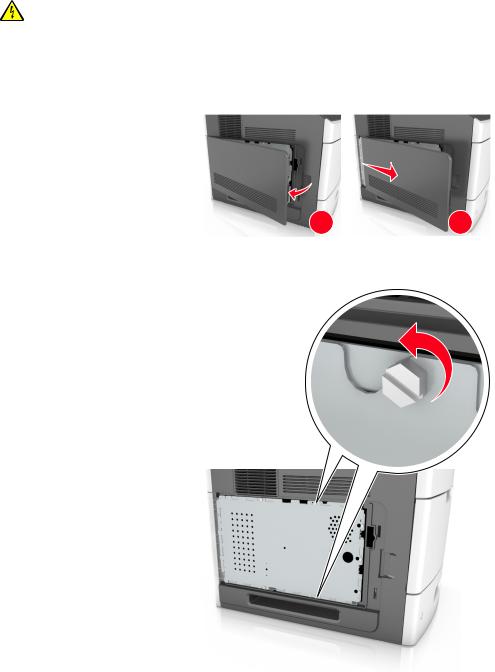
Additional printer setup |
14 |
CAUTION—SHOCK HAZARD: If you are accessing the controller board or installing optional hardware or memory devices sometime after setting up the printer, then turn the printer off, and unplug the power cord from the electrical outlet before continuing. If you have any other devices attached to the printer, then turn them off as well, and unplug any cables going into the printer.
1 Remove the controller board access cover.
1 |
2 |
|
|
2 Using a screwdriver, loosen the screws on the controller board shield.
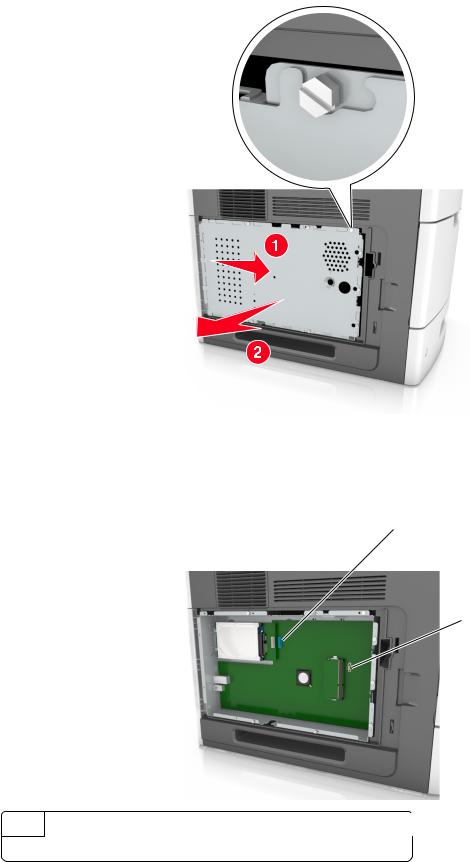
Additional printer setup |
15 |
3 Remove the shield.
4Use the following illustration to locate the appropriate connector:
Warning—Potential Damage: Controller board electronic components are easily damaged by static electricity. Touch a metal surface on the printer first before touching any controller board electronic component or connector.
1
2
 3
3
1 Lexmark Internal Solutions Port or printer hard disk connector
2 Option card connector

Additional printer setup |
16 |
3 Memory card connector
5 Align the screws with the holes on the shield, and then reattach the shield.

Additional printer setup |
17 |
6 Tighten the screws on the shield.
7 Reattach the access cover.
1 |
2 |
|
|
Installing a memory card
CAUTION—SHOCK HAZARD: If you are accessing the controller board or installing optional hardware or memory devices sometime after setting up the printer, then turn the printer off, and unplug the power cord from the electrical outlet before continuing. If you have any other devices attached to the printer, then turn them off as well, and unplug any cables going into the printer.
Warning—Potential Damage: Controller board electronic components are easily damaged by static electricity. Touch something metal on the printer first before touching any controller board electronic components or connectors.

Additional printer setup |
18 |
An optional memory card can be purchased separately and attached to the controller board.
1Access the controller board.
For more information, see “Accessing the controller board” on page 13.
2 Unpack the memory card.
Warning—Potential Damage: Do not touch the connection points along the edge of the card. Doing so may cause damage.
3 Align the notch (1) on the memory card with the ridge (2) on the connector.
1
2
4Push the memory card straight into the connector, and then push the card toward the controller board wall until it clicks into place.
5 Reattach the controller board shield, and then the controller board access cover.
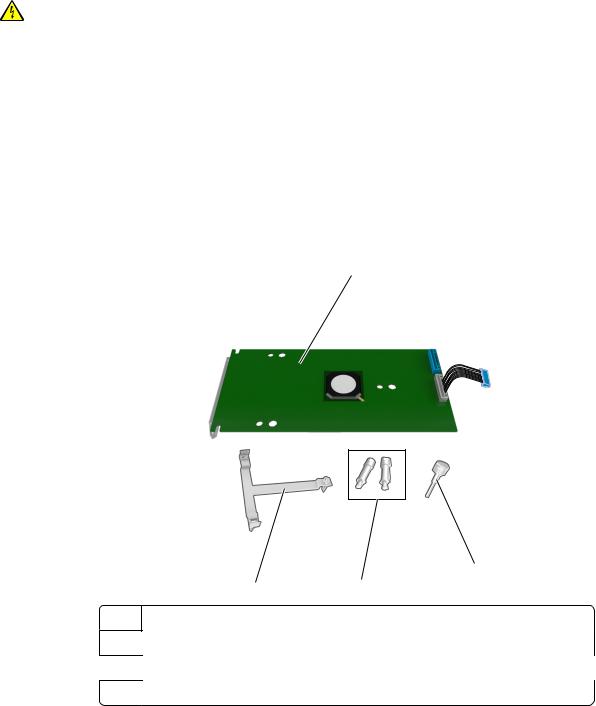
Additional printer setup |
19 |
Installing an Internal Solutions Port
The controller board supports one optional Lexmark Internal Solutions Port (ISP).
Note: This task requires a flat head screwdriver.
CAUTION—SHOCK HAZARD: If you are accessing the controller board or installing optional hardware or memory devices sometime after setting up the printer, then turn the printer off, and unplug the power cord from the electrical outlet before continuing. If you have any other devices attached to the printer, then turn them off as well, and unplug any cables going into the printer.
Warning—Potential Damage: Controller board electronic components are easily damaged by static electricity. Touch something metal on the printer first before touching any controller board electronic components or connectors.
1Access the controller board.
For more information, see “Accessing the controller board” on page 13.
2If an optional printer hard disk is installed, then remove the printer hard disk first. For more information, see “Removing a printer hard disk” on page 28.
3 Unpack the ISP kit.
1
2
4 |
3 |
1 ISP solution
2Screw for attaching the plastic bracket to the ISP
3Screws for attaching the ISP mounting bracket to the controller board shield
4 Plastic bracket
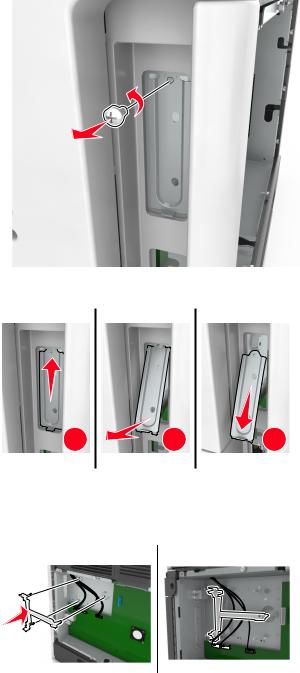
Additional printer setup |
20 |
4Remove the metal cover from the ISP opening. a Loosen the screw.
b Lift the metal cover, and then pull it out completely.
1 |
2 |
3 |
5Align the posts of the plastic bracket with the holes on the controller board cage, and then press the plastic bracket on the controller board cage until it clicks into place. Make sure the cables are neatly tucked under the plastic bracket.
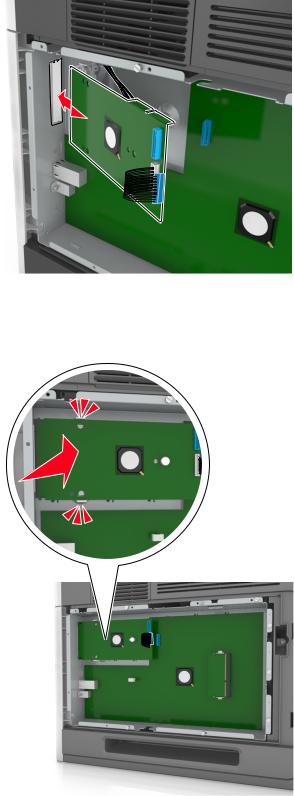
Additional printer setup |
21 |
6 Install the ISP on the plastic bracket.
Note: Hold the ISP at an angle over the plastic bracket so that any overhanging connectors will pass through the ISP opening in the controller board cage.
7 Lower the ISP toward the plastic bracket until the ISP is seated between the guides of the plastic bracket.

Additional printer setup |
22 |
8 Use the provided thumbscrew for the ISP to attach the plastic bracket to the ISP.
Note: Turn the screw clockwise, enough to hold the ISP in place, but do not tighten it yet.
9 Attach the two provided screws to secure the ISP mounting bracket to the controller board shield.
10Tighten the thumbscrew that is attached to the ISP.
Warning—Potential Damage: Do not screw it on too tightly.
11Connect the ISP solution interface cable into the receptacle of the controller board.
Note: The plugs and receptacles are color-coded.
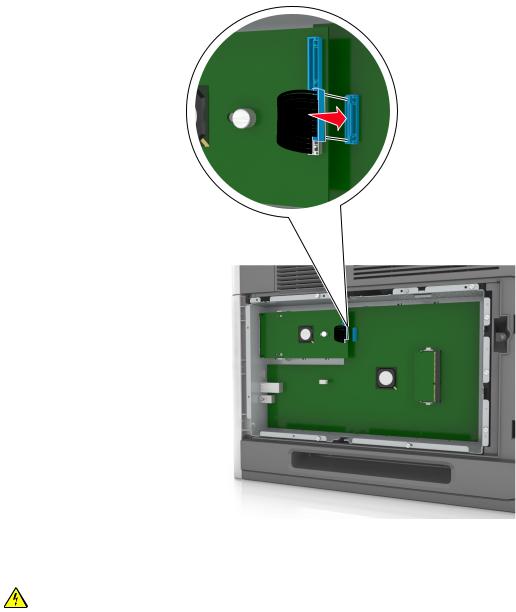
Additional printer setup |
23 |
Installing an optional card
CAUTION—SHOCK HAZARD: If you are accessing the controller board or installing optional hardware or memory devices sometime after setting up the printer, then turn the printer off, and unplug the power cord from the electrical outlet before continuing. If you have other devices attached to the printer, then turn them off as well, and unplug any cables going into the printer.
Warning—Potential Damage: Controller board electronic components are easily damaged by static electricity. Touch a metal surface on the printer before touching any controller board electronic components or connectors.
1Access the controller board.
For more information, see “Accessing the controller board” on page 13.
2Unpack the optional card.
Warning—Potential Damage: Avoid touching the connection points along the edge of the card.

Additional printer setup |
24 |
3 Holding the card by its sides, align the plastic pins (1) on the card with the holes (2) on the controller board.
1
 2
2
4 Push the card firmly into place as shown in the illustration.
Warning—Potential Damage: Improper installation of the card may cause damage to the card and the controller board.
Note: The entire length of the connector on the card must touch and be flushed against the controller board.
5Close the controller board access door.
Note: When the printer software and any hardware options are installed, it may be necessary to manually add the options in the printer driver to make them available for print jobs. For more information, see “Adding available options in the print driver” on page 36.
Installing a printer hard disk
Note: This task requires a flat head screwdriver.
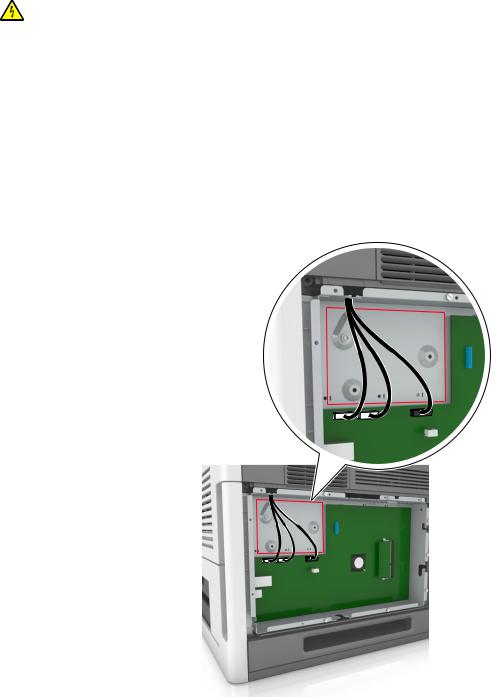
Additional printer setup |
25 |
CAUTION—SHOCK HAZARD: If you are accessing the controller board or installing optional hardware or memory devices sometime after setting up the printer, then turn the printer off, and unplug the power cord from the electrical outlet before continuing. If you have any other devices attached to the printer, then turn them off as well, and unplug any cables going into the printer.
Warning—Potential Damage: Controller board electronic components are easily damaged by static electricity. Touch something metal on the printer first before touching any controller board electronic components or connectors.
1Access the controller board.
For more information, see “Accessing the controller board” on page 13.
2 Unpack the printer hard disk.
3 Locate the appropriate connector on the controller board cage.
Note: If an optional ISP is currently installed, then the printer hard disk must be installed onto the ISP.
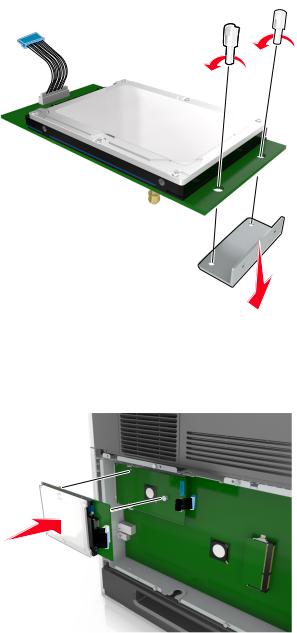
Additional printer setup |
26 |
To install a printer hard disk onto the ISP:
a Remove the screws attached to the printer hard disk mounting bracket, and then remove the bracket.
bAlign the standoffs of the printer hard disk to the holes in the ISP, and then press the printer hard disk down until the standoffs are in place.
Installation warning: Hold only the edges of the printed circuit board assembly. Do not touch or press on the center of the printer hard disk. Doing so may cause damage.
cInsert the plug of the printer hard disk interface cable into the receptacle of the ISP.
Note: The plugs and receptacles are color coded.
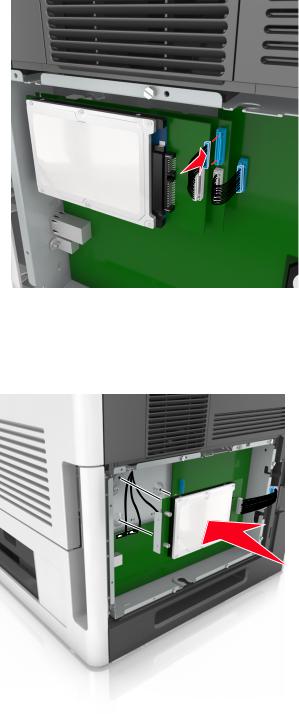
Additional printer setup |
27 |
4Align the standoffs of the printer hard disk to the holes in the controller board cage, and then press the printer hard disk down until the standoffs are in place.
Installation warning: Hold only the edges of the printed circuit board assembly. Do not touch or press on the center of the printer hard disk. Doing so may cause damage.
Note: Make sure the cables are neatly tucked under the printer hard disk.
5Insert the plug of the printer hard disk interface cable into the receptacle of the controller board.
Note: The plugs and receptacles are color coded.
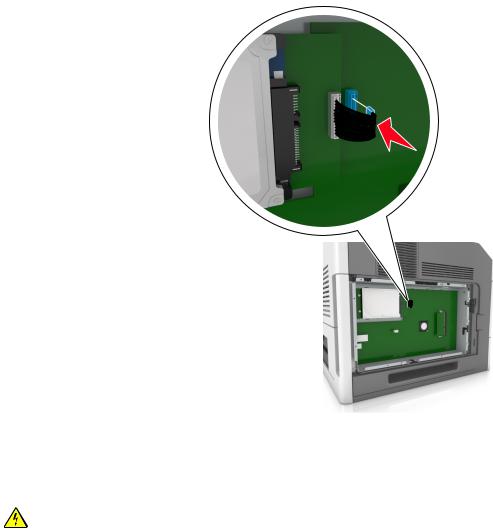
Additional printer setup |
28 |
Removing a printer hard disk
Note: This task requires a flat head screwdriver.
CAUTION—SHOCK HAZARD: If you are accessing the controller board or installing optional hardware or memory devices sometime after setting up the printer, then turn the printer off, and unplug the power cord from the electrical outlet before continuing. If you have any other devices attached to the printer, then turn them off as well, and unplug any cables going into the printer.
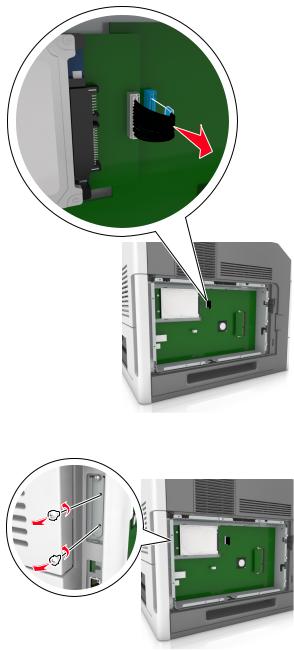
Additional printer setup |
29 |
Warning—Potential Damage: Controller board electronic components are easily damaged by static electricity. Touch a metal surface on the printer before touching any controller board electronic components or connectors.
1Access the controller board.
For more information, see “Accessing the controller board” on page 13.
2Unplug the printer hard disk interface cable from the controller board, leaving the cable attached to the printer hard disk. To unplug the cable, squeeze the paddle at the plug of the interface cable to disengage the latch before pulling out the cable.
3 Remove the screws holding the printer hard disk in place.

Additional printer setup |
30 |
4 Remove the printer hard disk.
5 Set aside the printer hard disk.
Installing hardware options
Order of installation
CAUTION—POTENTIAL INJURY: The printer weight is greater than 18 kg (40 lb) and requires two or more trained personnel to lift it safely.
CAUTION—SHOCK HAZARD: If you are accessing the controller board or installing optional hardware or memory devices sometime after setting up the printer, then turn the printer off, and unplug the power cord from the electrical outlet before continuing. If you have any other devices attached to the printer, then turn them off as well, and unplug any cables going into the printer.

 CAUTION—TIPPING HAZARD: Floor-mounted configurations require additional furniture for stability.
CAUTION—TIPPING HAZARD: Floor-mounted configurations require additional furniture for stability.  You must use either a printer stand or printer base if you are using multiple input options. If you purchased a printer with a similar configuration, then you may need additional furniture. For more information, see www.lexmark.com/multifunctionprinters.
You must use either a printer stand or printer base if you are using multiple input options. If you purchased a printer with a similar configuration, then you may need additional furniture. For more information, see www.lexmark.com/multifunctionprinters.
Install the printer and any hardware options you have purchased in the following order:
•Caster base
•2100 sheet tray or spacer
•Optional 550 or 250 sheet tray
•Printer
For more information on installing a caster base, optional 550 or 250 sheet tray, spacer, or 2100 sheet tray, see the setup sheet that came with the option.
